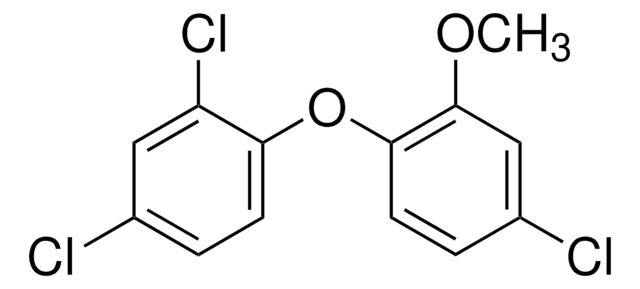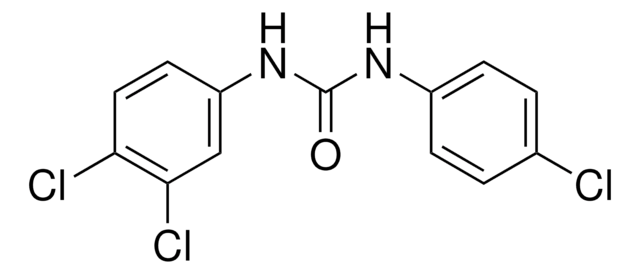PHR1338
Triclosan
Pharmaceutical Secondary Standard; Certified Reference Material
Synonym(s):
Triclosan, 5-Chloro-2-(2,4-dichlorophenoxy)phenol, Irgasan
About This Item
Recommended Products
grade
certified reference material
pharmaceutical secondary standard
Quality Level
Agency
traceable to USP 1682206
API family
triclosan
CofA
current certificate can be downloaded
technique(s)
HPLC: suitable
gas chromatography (GC): suitable
application(s)
pharmaceutical (small molecule)
format
neat
storage temp.
2-30°C
SMILES string
Oc1cc(Cl)ccc1Oc2ccc(Cl)cc2Cl
InChI
1S/C12H7Cl3O2/c13-7-1-3-11(9(15)5-7)17-12-4-2-8(14)6-10(12)16/h1-6,16H
InChI key
XEFQLINVKFYRCS-UHFFFAOYSA-N
Looking for similar products? Visit Product Comparison Guide
General description
Triclosan is a non-ionic broad spectrum antibacterial and antifungal agent, used in personal care products such as antiseptic soaps, toothpastes, fabrics and plastics.
Application
Biochem/physiol Actions
Analysis Note
Other Notes
Footnote
Signal Word
Warning
Hazard Statements
Precautionary Statements
Hazard Classifications
Aquatic Acute 1 - Aquatic Chronic 1 - Eye Irrit. 2 - Skin Irrit. 2
Storage Class Code
11 - Combustible Solids
WGK
WGK 2
Flash Point(F)
Not applicable
Flash Point(C)
Not applicable
Regulatory Listings
Regulatory Listings are mainly provided for chemical products. Only limited information can be provided here for non-chemical products. No entry means none of the components are listed. It is the user’s obligation to ensure the safe and legal use of the product.
PRTR
Class I Designated Chemical Substances
JAN Code
PHR1338-1G-PW:
PHR1338-1G:
Choose from one of the most recent versions:
Already Own This Product?
Find documentation for the products that you have recently purchased in the Document Library.
Customers Also Viewed
Our team of scientists has experience in all areas of research including Life Science, Material Science, Chemical Synthesis, Chromatography, Analytical and many others.
Contact Technical Service














